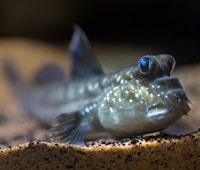Listening practice on mudskippers
Listening practice on mudskippers
A mudskipper, a fish that spends most of its life out of the sea. It can walk on land and breathe air. Its life is very different from that of most fish. A fish out of water? Maybe, but they thrive here in Japan.
So, what’s made this upheaval worthwhile? The answer lies in the mud. As the tide retreats, it exposes mud flats. Sunlight hits the rich silt, and tiny plants and animals flourish there; all food for a mudskipper.
But life on land is not without problems. It’s hard work to find a mate. Jumping high above the mud will get you noticed. With eyes perched on the top of their heads, the mudskippers keep a lookout for both friend and foe, and males fight those who intrude their territory.
They must also take care not to dry out in the sun. Rolling in the boilers keeps the skin cool and moist. For this small species, a better option is to retreat underground. So, he digs himself a tunnel down into the mud. So, his heap of spoil is an indication of the extent of his excavations. With the tide flooding the tunnel twice a day, maintenance is a real burden.
Reading comprehension
Mudskippers are known for their unusual looks and the interesting abilities that they possess for being a fish that can survive both in and out of water. They can grow up to twelve inches long and most of them are a brownish green color that range anywhere from dark to light. During mating season the males will also develop brightly colored spots on them in order to attract the females. The spots can be red, green and even blue. They are also known for their protruding eyes found on the very top of their flat head. Their most noticeable feature however is their side pectoral fins that are located more forward and under their elongated body. These fins function similarly to legs in that they allow the mudskipper to move from place to place. Although having the typical appearance of any other fish, these forward fins allow the mudskipper to “skip” across muddy surfaces and even give them the ability to climb trees and low branches. Because of these fins, mudskippers have also been found to be able to leap distances of up to two feet.
Source: https://en.wikipedia.org/



